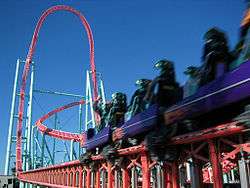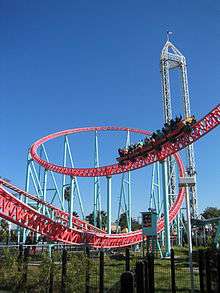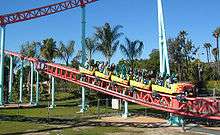Xcelerator
| Xcelerator The Ride | |
|---|---|
 | |
| Knott's Berry Farm | |
| Park section | The Boardwalk |
| Coordinates | 33°50′45″N 118°00′03″W / 33.84583°N 118.00083°WCoordinates: 33°50′45″N 118°00′03″W / 33.84583°N 118.00083°W |
| Status | Operating |
| Opening date | June 22, 2002 |
| Cost | $13,000,000 |
| Replaced | Windjammer Surf Racers |
| General statistics | |
| Type | Steel – Launched |
| Manufacturer | Intamin |
| Designer | Werner Stengel |
| Model | Accelerator Coaster |
| Track layout | Dual Overbank Figure 8 |
| Lift/launch system | Hydraulic catch car launch |
| Height | 205 ft (62 m) |
| Length | 2,202 ft (671 m) |
| Speed | 82 mph (132 km/h) |
| Inversions | 0 |
| Duration | 1:02 (25 seconds from launch to brakes) |
| Max vertical angle | 90° |
| Capacity | 1,330 riders per hour |
| Acceleration | 0 − 82 mph (132 km/h) in 2.3 seconds |
| Height restriction | 52 in (132 cm) |
| Trains | 2 trains with 5 cars. Riders are arranged 2 across in 2 rows for a total of 20 riders per train. |
|
| |
|
Xcelerator The Ride at RCDB Pictures of Xcelerator The Ride at RCDB | |
Xcelerator is a steel launched roller coaster at Knott's Berry Farm in Buena Park, California. It was Intamin's first hydraulically launched coaster, while also the fourth Intamin installation at Knott's, alongside The Sky Cabin, Bigfoot Rapids, and Perilous Plunge (removed in 2012). Xcelerator was standing but not operating from July 2017 but the coaster finally reopened on March 24, 2018.[1]
The ride
Xcelerator's powerful hydraulic catapult motor accelerates the train from 0 to 82 mph (132 km/h) in 2.3[2] seconds (about 1.62 g). It only uses 157 feet (48 m) of track to launch the train. The twin hydraulic catapult motor achieves a maximum of 10,500 horsepower (7,800 kW) each while accelerating the train. Xcelerator's hydraulic motor system has the mechanical capability of accelerating vehicles to a speed of 117 miles per hour (188 km/h) or more, though it only needs to hit 82 mph (132 km/h) for the train to crest the hill. In order for a train to launch, the train must "drift" back to "hook" on to a catch car. Twenty-four volts are used to demagnetize a pin underneath the third car, which causes it to drop. At the same time, two bellows actuators fill up with air. Meanwhile, near the back of the train, two drive tires that are holding the train in place begin to retract. The brakes will lower while the train rolls back to hook into the catch car—which is over 7 feet (2.1 m) long. Once connected the motor will engage to launch the train. The catch car passes over its own set of magnetic brakes to retard it. The motor has to work harder to attain launch speed if the train is not loaded with enough riders. On occasion, the catch car can overshoot its end position if it cannot attain the proper speed within set parameters, which causes it to stall near the end of the launch track. The train must also clear the launch track within three seconds. If it does not the ride will shut down. From the time the launch begins, the train has 8.25 seconds to pass over a proximity switch (Hall effect sensor) near the bottom of the first drop which clears the starting block. If the train does not pass over the switch within the given time frame, the ride will shut itself down.
After the launch the train crests a vertical 205 ft (62 m) top hat element, then soars through a 110 ft (34 m) and 95 ft (29 m) over banked turns, and glides to a smooth stop though brake run and returns to the station house. The magnetic braking system consists of mounted magnetic clippers on the trains and copper alloy fins mounted onto the track. The alloy fins on the launch section retract during the launch procedure so as to not interfere with the train. In a case of a rollback, the magnetic brakes retard the train. They are raised section by section after the train has passed over them. The brake fins on the brake run are stationary and cannot be lowered. The train is traveling at approximately 67 miles per hour (108 km/h) when entering the brake run.
The trains

Xcelerator features two trains: red and violet. The trains themselves have spring-loaded wheel assemblies and are standard Intamin trains with specially crafted shells to make them look like 1957 Chevrolet Bel Air convertibles. The red train was accidentally painted with its color scheme reversed when the ride opened. It featured a yellow color scheme with red flames in the front and side, instead of a red train with yellowish flames. During one of the ride's rehabs, the color scheme was corrected by repainting the red train with orange flames added to the front and sides. After an accident in 2009, the red train now features patriotic blue flames. Each train is five cars long and holds twenty passengers. A maximum of two trains can operate at any given time. However, the two train operation is only slightly more efficient than only using one train. Therefore, Xcelerator usually only operates with one train regardless of the number of people in the park. Instead, each train is used by itself for about a year, while the other is undergoing maintenance. When maintenance is completed on one of the trains, it is returned to active duty and the other train is sent to maintenance.
Restraints
Xcelerator's trains use hydraulically operated T-Bar lapbar restraints. These restraints are featured on Intamin's earlier accelerator coaster models. However, over-the-shoulder restraints are now used on the newer models due to safety concerns. Xcelerator also had special light meters installed on the restraints. The meter must show all green in order for a guest to ride. If the meter shows red then the guest cannot ride. Eventually the meter system was removed and the park now uses black lines etched on the side of each restraint. The black line must pass a certain part of the seat frame in order for the guest to ride. The ride also has seat belts that must be buckled before an operator pulls down the lapbar. Failure to do so slows the load time considerably. Another contributing factor involving the seat belts and a guest not being able to ride is requirement of one inch of slack must be pulled from the seat belt.
Limitations
Rollbacks

Occasionally, a train will not attain enough speed to make it over the initial 205-foot (62 m) top hat element. Instead, the train will partially ascend the tower, stall, and then roll back into magnetic brake fins situated on the launch track. This is known as a rollback and is part of the normal design of the ride. A rollback can cause the ride to close for an indefinite amount of time while the ride is reset and a sufficient number of test launches are performed. Rain, weight, frequency of launching, outside temperature, and overheating can contribute to a rollback.
Weather
The ride will not operate in the rain, even during drizzling conditions. This is to prevent rollbacks due to hydroplaning on the launch track. The track usually needs to dry until maintenance has cleared it to operate again before the first test launch is made. This is to reduce the chance of a rollback as well as preventing accidents.
Progression to taller and faster, inversion rides
Xcelerator laid the groundwork for taller and faster rides such as Top Thrill Dragster at Cedar Point and Kingda Ka at Six Flags Great Adventure, coasters both passing the 400-foot (120 m) mark and 100 mph (160 km/h) mark. Xcelerator also laid the groundwork for rides featuring inversions, such as Storm Runner at Hersheypark, which has banked inversions, and Kanonen at Liseberg, which featured a vertical loop.
While successful in doing this, modifications were made to the larger models. Storm Runner and Kingda Ka use dual loading stations to speed up dispatching times, as well as larger and more-powerful motors.
Lower-powered coasters have been built as well, such as Rita at Alton Towers.

Incidents
- On September 16, 2009 a cable snapped during the launch of the ride, sending pieces of debris flying and lacerating the left leg of 12-year-old Kyle Wheeler. Both he and an adult male rider, who complained of back pain, were sent to the hospital.[3] The adult was released, but Kyle has undergone multiple surgeries to repair the damaged muscle tissue in his leg. His father, Russel Wheeler, was sitting beside him when the cable snapped. The Wheelers won an undisclosed amount of money in a lawsuit against the park. The ride has since been reopened.
- On August 7, 2013, the cable snapped during the launch of the ride, which again sent debris flying in the air, however, nobody was hurt. The ride reopened about a month later.
- On January 31, 2016 during a test run, the violet train was stalled at the top of the top-hat hill. It was there for an hour and a half before it eventually rolled backward after it was blown over by the wind. Nobody was injured.
Television appearances
- Xcelerator appeared on Smash Lab in an episode about Magnetic Braking
- Xcelerator appeared in the movie Knocked Up
- Xcelerator was the last level on the Cartoon Network TV show BrainRush.
- Xcelerator was featured on an episode of Paris Hilton's My New BFF.
- Xcelerator was shown in the E! reality show, The Girls Next Door
- Xcelerator appeared in an episode of the DIY Network's show "Man Caves", in which reality TV star Bert the Conqueror rode the coaster
References
- ↑ http://www.screamscape.com/html/knott-s_berry_farm.htm
- ↑ "California's Best Theme Park and Amusement Park - Knott's Berry Farm". Archived from the original on July 22, 2009. Retrieved 18 June 2016.
- ↑ "two additional riders were injured as well". ABC 7. September 18, 2009. Retrieved September 12, 2016.
External links
| Wikimedia Commons has media related to Xcelerator. |
- Official Xcelerator page
- Xcelerator Pictures on Ultimate Rollercoaster.com.